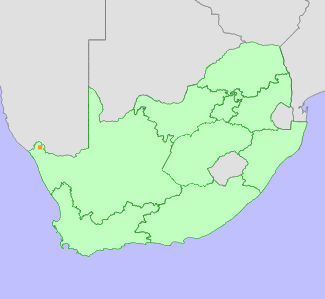|
Scientific Name | Conophytum taylorianum (Dinter & Schwantes) N.E.Br. subsp. rosynense S.A.Hammer |
Higher Classification | Dicotyledons |
Family | AIZOACEAE |
National Status |
Status and Criteria | Endangered A3cd |
Assessment Date | 2021/12/09 |
Assessor(s) | A.J. Young, P.G. Desmet, I. Ebrahim, D. Guo, A. Harrower, L. Jabar, L. Knoetze, C. Rodgerson, P.C.V. Van Wyk & N.N. Mhlongo |
Justification | This succulent is endemic to the Northern Cape province of South Africa with an extent of occurrence (EOO) of 172 km2 and area of occupancy (AOO) of 32 km2. The dwarf succulents that comprise this genus have been increasingly targeted by illegal collection in recent years and the vast majority of species are in high demand by collectors. Whilst there is no evidence of illegal collection at the time of this submission, closely related taxa, including some from the immediate area, have been illegally removed from habitat with a dramatic increase in the number of species and volume of plants targeted since 2019. The threat of illegal collection is therefore regarded as very high for this particular succulent and a population reduction of 50% is suspected over three generations (90 years). Anthropogenic climate change is expected to cause a population reduction of 70% by 2080. It therefore qualifies as Endangered under criterion A3. |
Distribution |
Endemism | South African endemic |
Provincial distribution | Northern Cape |
Range | This dwarf succulent is endemic to Richtersveld in the Northern Cape province of South Africa where it is found in 5-10 locations. |
Habitat and Ecology |
Major system | Terrestrial |
Major habitats | Rosyntjieberg Succulent Shrubland |
Description | This taxon is endemic to the Richtersveld bioregion in Succulent Karoo biome. The plants prefer shade and are typically found on sheltered, south-facing cliff faces at high altitude usually occupying crevices and cracks.
This succulent has a generation length of 30 years. It is expected to be sensitive to the impacts of climate change as it does not disperse and while adapted to arid conditions, is dependent on limited seasonal rainfall. Species in the genus are sensitive to long periods of drought. Drought related mortality has been observed for other closely related taxa within the genus. |
Threats |
| This particular taxon is not currently threatened by illegal collection but it is likely that it will become a target in coming years as there has been a dramatic increase in the number of species and volume of plants of this genus targeted since 2019. The remoteness and general inaccessibility of many of the known localities is likely to restrict future decline due to this activity to 50% of the population.
Anthropogenic climate change is a long-term threat to this taxon. Climate models for the likely emission scenarios where emissions stay at present day levels (RCP 2.6) (Hausfather and Peters 2020) and worst case scenarios where emissions continue to increase during the 21st century (RCP 8.5) indicate that there will be a loss of suitable bioclimatic envelope of between 90% and 99% by 2080 for this succulent. However, as this taxon typically occurs in a sheltered habitat and possesses certain traits likely to afford resilience to xerophytic conditions it is expected to have a level of resilience to climate change and the expected population loss is reduced by 20% to 70%. Species in this genus have limited dispersal ability and migration to suitable habitats elsewhere is regarded as highly unlikely. |
Population |
The inaccessible nature of the locality means there is little information on population size. This may be locally abundant at some subpopulations but is often seen as scattered individuals. The population size is estimated at no more than 5,000 mature individuals. This taxon can be locally abundant, however in response to an extended drought in the Richtersveld that started in 2016 and is still ongoing at the time of assessment, the population is suspected to be declining.
|
Population trend | Unknown |
Assessment History |
Taxon assessed |
Status and Criteria |
Citation/Red List version | | Conophytum taylorianum (Dinter & Schwantes) N.E.Br. subsp. rosynense S.A.Hammer | Rare | 2015.1 | | Conophytum taylorianum (Dinter & Schwantes) N.E.Br. subsp. rosynense S.A.Hammer | Least Concern | Raimondo et al. (2009) | |
Bibliography |
Hammer, S. 2002. Dumpling and his wife: New view of the genus Conophytum. EAE Creative Colour, Norwich.
Hammer, S.A. 1993. The genus Conophytum: A conograph. Succulent Plant Publications, Pretoria.
Hausfather, Z. and Peters, G.P. 2020. Emissions - the 'business as usual' story is misleading. Nature 577(618-620).
Opel, M.R. 2004. The rediscovery of Crassula alcicornis. Haseltonia 10:38-40.
Raimondo, D., von Staden, L., Foden, W., Victor, J.E., Helme, N.A., Turner, R.C., Kamundi, D.A. and Manyama, P.A. 2009. Red List of South African Plants. Strelitzia 25. South African National Biodiversity Institute, Pretoria.
|
Citation |
| Young, A.J., Desmet, P.G., Ebrahim, I., Guo, D., Harrower, A., Jabar, L., Knoetze, L., Rodgerson, C., Van Wyk, P.C.V. & Mhlongo, N.N. 2021. Conophytum taylorianum (Dinter & Schwantes) N.E.Br. subsp. rosynense S.A.Hammer. National Assessment: Red List of South African Plants version 2024.1. Accessed on 2025/10/22 |
 Comment on this assessment
Comment on this assessment


